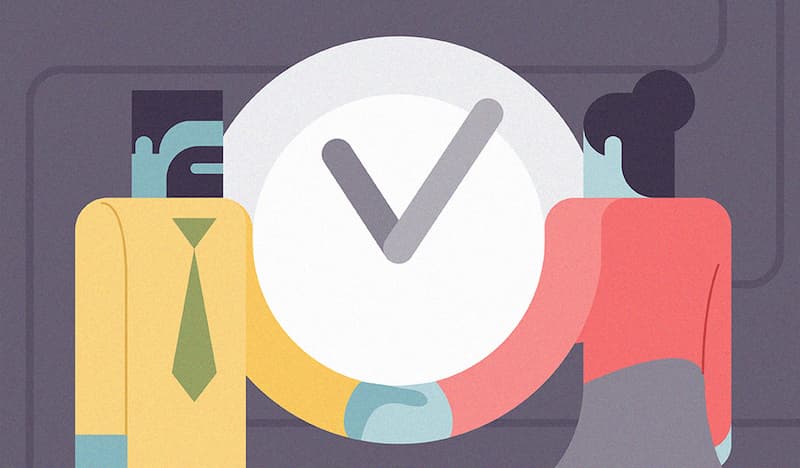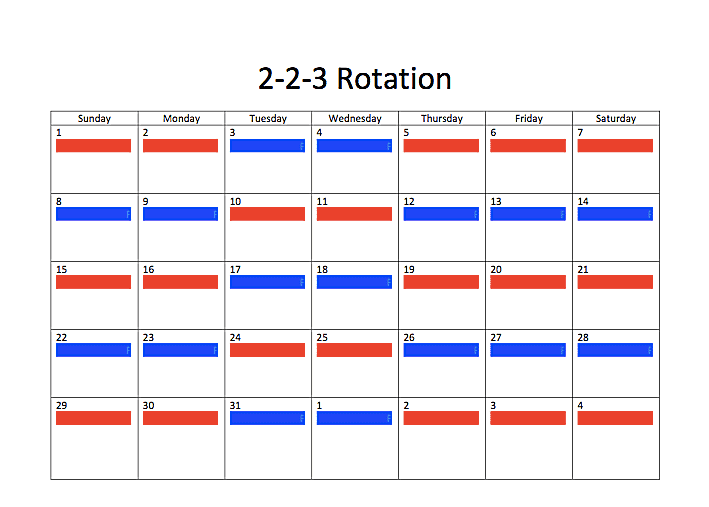A split shift is a work schedule that is broken up by employer-determined non-paid breaks that aren’t legitimate rest or meal times.
If you’re a restaurant manager, you know it can be tough to schedule your employees around service times and rush periods. especially if they are used to working an eight- or ten-hour shift without interruption. Thankfully, there is a solution: the split shift.
Please continue reading so I can give you more specific information about what a split shift is.
Table of Contents
What Is A Split Shift?
A split shift is a type of work schedule in which the workday of an employee is split into two or more segments.
It’s crucial to realize that a split shift does not include the typical one-hour lunch break associated with a 9-to-5 schedule. A typical split shift has gaps of two hours or more.
You might book a server starting at 10 a.m. in a restaurant, for instance. to 2 p.m. (to cover the lunch rush) and again from 6 p.m. to 10 p.m. (to cover the dinner service). Even though the employee’s workday spanned a 12-hour period, they only worked eight hours with a four-hour break in between.
Read about What Is A Swing Shift?
The Person Who Starts A Split Shift
As with all scheduling procedures, only you, the manager, are permitted to designate two distinct work periods as a split shift. Although an employee may take a break for an emergency or personal reasons (with your approval, of course) and then return to finish their work, this does not constitute a split shift.
You must take the initiative to start the split shift and note it on the master schedule. Additionally, for the split to be legal, the employee frequently needs to leave the workplace during the interval between shifts.
See more about: Accommodate Everyone Schedule Meaning. Ensure that the funds are sufficient to cover everyone’s needs. to give someone a place to dwell or stay…

Split Shift Pros
Let’s examine the advantages of implementing a split shift:
Increased Employee Productivity
Work hours are inversely proportional to employee productivity.
The productivity decreases with increased working time. This is because longer workdays can result in stress, exhaustion, and even a loss of concentration.
However, by using a split shift schedule, you can give your employees a much-needed 3–4 hour break.
Because they only need to work for four hours at a time, they actually put in the same amount of time as a traditional 9–5 shift worker, despite their workday appearing longer.
More Time For Personal Errands
Employees may complete some time-sensitive tasks during a longer lunch break.
This could apply to activities that call for their physical presence, such as bank transactions, doctor visits, PTA meetings, and the like.
Employees who work in split shifts don’t have to take any time off, forfeit pay due to working fewer hours, or put in an extra hour to make up for a lengthy break.
Improved Work-life Balance For Employees
Split shifts frequently enable workers to run errands, look after a relative, or even pick up their children from school. They can even simply take a sound nap without interfering with their workday, if nothing else.
This can help create a better work-life balance, increasing employee engagement and productivity at work.
Keep Control Of Overhead Costs
As an employer, implementing a split shift can be a smart way to keep your expenses in check and lower overhead costs.
With the help of this schedule, you can grant some employees an unpaid break when they are not in use. Then, you can ask them to return during busy times to make sure they work a full day’s worth of six to eight hours.
It can significantly lower your labor costs, guarantee that workers aren’t overworked, and ensure that you always have enough workers available when you need them.
Read about: What Is A 2-2-3 Schedule
Split Shift Cons
A split shift schedule has some restrictions just like any other kind of work schedule:
Reduced Sleep Hours
If an employee works the night shift, they may frequently go to bed late, which is a significant health disadvantage of the split shift arrangement. The quantity of sleep they get at night may be significantly reduced as a result.
The health and productivity of your staff members can suffer greatly from getting less sleep. Therefore, before implementing a split work schedule, it is crucial to take this factor into account.
Can Be Hard To Collaborate With Team Members
In a split shift scenario, it may be more difficult to collaborate with team members, especially those working a traditional full-time shift.
This is especially true for knowledge workers or those who work in an office environment.
For instance, if they take their midday break while others are working, it can seriously hinder communication. However, by utilizing clever collaboration tools, you can get around the problem of split shift work.
Not Ideal For Long Commutes
Another drawback of a split shift schedule is that it might not be practical for workers who have a long commute.
They might use a significant portion of their lunch break for travel, making them even more exhausted when they arrive at work.
Read about: Work To Live Or Live To Work
Are Split Shifts Legal?
Split shifts are now subject to regulation in some states and localities due to the ongoing debate over the fair workweek and labor laws. However, they are not prohibited by any federal laws. In some locations, employers may be obligated to contribute premiums whenever an employee works a split shift. Here are a few instances of laws that are relevant in the US:
California
Any work schedule that is disrupted by unpaid time during a single workday, aside from customary rest and meal periods, is referred to as a split shift in California. When a worker works split shifts, they are entitled to compensation equal to one hour of their standard hourly rate. Consider, for instance, a worker at a grocery store who makes $10 per hour and starts at 10 a.m. to noon and, then, works from 2 to 8 p.m. Since they receive their regular pay of $80 in addition to a $10 premium, they would make $90 overall for the workday.
Oregon
Even more severe financial penalties may apply under Oregon’s split shift laws. Employees must receive a 10-hour break in between shifts, as mandated by these laws. Employees are entitled to time and a half pay any time the break between shifts falls below this threshold. Therefore, splitting their shift would require you to pay them $120 instead of their usual $80 per eight-hour shift.

Considerations For A Split Shift Schedule
You’re now prepared to incorporate shift splitting into your employee schedule; however, before you do so, make sure you are aware of and abide by the split shift scheduling regulations in your area.
Communicate frequently and early with your staff as you plan your split shift schedule. The earlier an employee knows when they will be needed at work, the lower the likelihood that any problems will develop.
Even your hiring procedures can go one step further in this regard. Inquire during the interview process if the candidates are willing to work in shifts. As a result, when you select the successful applicant, they will already be acquainted with how your restaurant functions.
Read about: Accepted Job Offer Haven’t Heard Back
Tips For Working With Split Shifts
Know the Local and Federal Laws
Before implementing split shifts in your company, be sure to check all applicable federal, state, and local laws. More specifically, reference The Federal Fair Labor Standards Act. In addition, research the laws governing split-shift premiums and the distribution of hours if your company is based in California or New York.
Consult a labor lawyer who is familiar with the regulations in your region if you want to be absolutely certain that you are scheduling your employees fairly and legally in accordance with local, state, and federal statutes.
Factor in Commute Time
A sizeable portion of your employees’ non-work time may be spent in the commute to and from work. Be sure to account for the time, effort, and cost involved in leaving and returning to work if you decide to implement a split shift in your company.
Keep Meticulous Records
You and your staff must keep thorough records of all split-shift activities. This includes:
- Start times
- Stop times
- Meal breaks (if applicable)
- When the split shifts should start and end
- Total daily hours worked
It’s crucial to spell out the requirements of the split shift in your employee handbook in addition to maintaining your own records on hand.

Is a Split Shift Right for Your Business?
For some businesses, a split shift is not practical. Due to the lack of activity lulls during certain hours of the day, office environments typically don’t benefit from this type of schedule.
However, it can address many of the scheduling and financial problems that managers frequently face in the food service, call center, transportation, and hospitality industries (where there is a significant lull at certain times).
Editor’s pick: How long will it take me to get to work really? How to cut commuting time? Click here!
FAQs About A Split Shift
How Much Is The Split Shift Premium?
The split shift premium is one hour at the state minimum wage or, if there is one, the local minimum wage, whichever is higher. Any income earned in excess of the federal, state, or local minimum wage will be deducted from the employer’s obligation to pay the split shift premium. Please see number 6 for an example of how the split shift premium is calculated.
Who Is In Charge Of Recording The Split Shift Payment?
It is legally required of your employer to maintain complete time logs of the hours worked and payroll records.
Does The Split Shift Premium Have To Be Listed Separately On The Pay Stub?
On the pay stub that is given to the employee, the employer must list each premium payment in detail. Split Shift Premium should be displayed as a separate category rather than being included in another category like wages, bonuses, etc.
Conclusion
If you’re worried that scheduling a split shift will be challenging, don’t be; with the right tools, it won’t be. Even the most complicated split shifts, rotating shifts, and night shifts are made simple by scheduling software like Sling. Simply sit down, create a schedule, and then proceed to more important issues.
We appreciate your reading.



